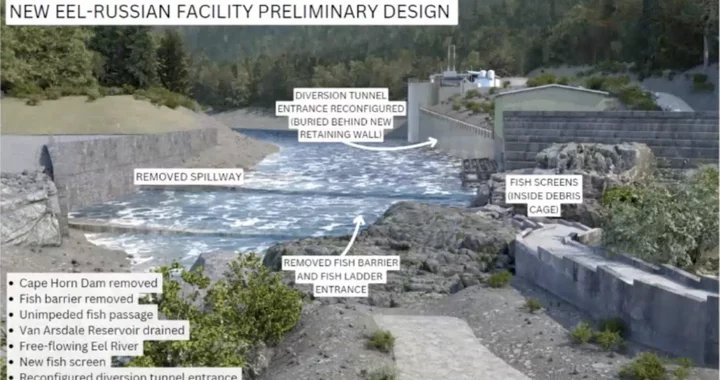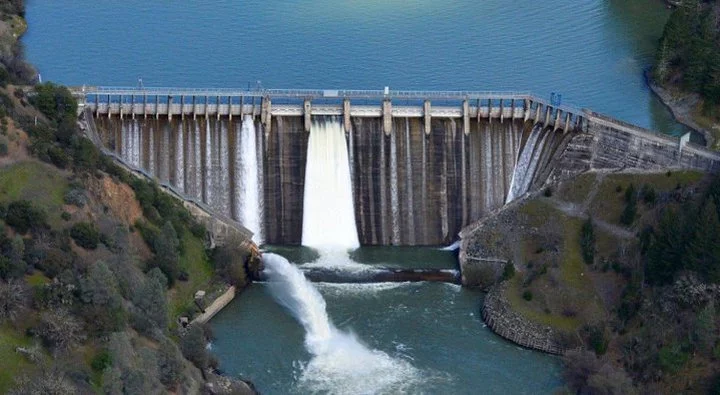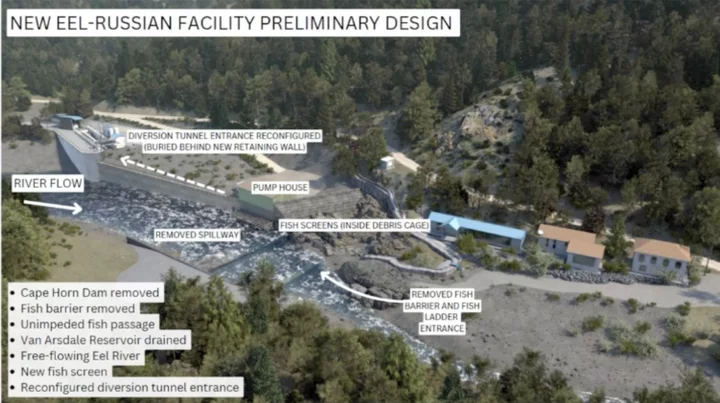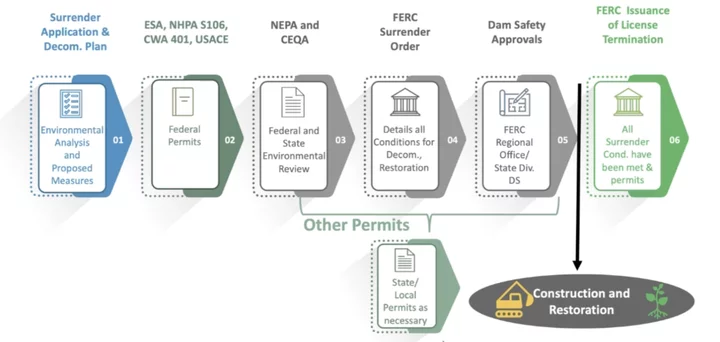Scott Dam, with Lake Pillsbury behind it. | Photo: PG&E
###
At a virtual town hall meeting last night, Pacific Gas & Electric Company officials went over the painstaking federal regulatory process that lies ahead as the utility prepares to decommission and dismantle the defunct Potter Valley Project — a two-dam hydroelectric system that has delivered flows from the Eel River basin to communities in the Russian River watershed for more than 100 years.
PG&E recently submitted a Surrender Application and Decommissioning Plan for the defunct hydropower project to the Federal Energy Regulatory Commission (FERC), kicking off a years-long governmental and public review process.
If the proposal moves forward as planned, PG&E will demolish much of the power station, which has been offline since 2021, and tear down both Scott and Cape Horn dams, draining Lake Pillsbury in Lake County and Van Arsdale Reservoir in Mendocino County. Once demolition is complete, the Eel-Russian Project Authority (ERPA) will assume responsibility for the diversion tunnel and construct the New Eel-Russian Facility (NERF) at the Cape Horn Dam site to ensure the continued transfer of flows to the Russian River. The whole process is expected to take at least 10 years to complete.
Digital renderings of the new water diversion project. | Image via ERPA.
While last night’s meeting largely focused on the tedious FERC regulatory process and timeline for decommissioning, one simple question from the public stood out from the rest: “What is the benefit of removing the dams? I’m not understanding why this needs to be done.”
In short, the project is economically unsustainable, said PG&E Senior License Project Manager Tony Gigliotti.
“It’s a very small project, and it’s very costly to operate for us,” he said. “It has not generated at that capacity for quite some time, and ultimately, it’s in our customers’ best interest for the project to be surrendered and decommissioned because we could purchase the generating capability on the open market for less than what it was costing us to generate. It wasn’t an easy decision for us.
“We understand the importance of the project to the area … and it took a lot of thought for us to come to that determination.”
In 2019, PG&E informed FERC that it would not renew its license for the Potter Valley Project, which initiated the so-called “orphan” process to find other entities interested in relicensing the project. However, no one went through the process, and FERC “cannot require a licensee to keep and operate a project,” Gigliotti said.
“In 2022, when nobody completed those steps, FERC requested that PG&E provide a plan and schedule for the surrender and decommissioning of the project,” he continued. “We provided the plan and schedule, made two drafts of our Surrender Application and Decommissioning Plan available to the public, and then filed [the final document] last month on July 25.”
After its initial review, FERC and PG&E will move on to federal permitting, environmental review through the National Environmental Policy Act (NEPA) and the California Environmental Quality Act (CEQA), as depicted in the timeline below.
“Next, FERC will issue a surrender order … which will contain a list of conditions that need to be implemented by PG&E,” Gigliotti said. “The issuance of that order from FERC doesn’t mean that construction starts right away. It means you may start implementing the following conditions. … There could be a one- to two-year gap between the issuance of the order and when PG&E is out in the field performing construction activities.”
The decommissioning process is expected to wrap up by 2030, but construction of the NERF could take another five years.
The proposal to demolish the upper Eel River dams has drawn both praise and criticism from Northern California communities that have long been at odds over ownership and control of water diverted from the Eel River. Still, a great many of them have been able to set aside their differences to join ERPA — a joint powers authority representing Sonoma Water, Mendocino Inland Water and Power Commission, Round Valley Indian Tribes, California Trout, Trout Unlimited and the California Department of Fish & Wildlife.
Last month, each of the aforementioned parties, as well as the Humboldt County Board of Supervisors, approved water diversion agreements in support of dam removal.
“Partners came together in what’s termed the ‘two-basin partnership’ to try to achieve two co-equal goals,” said ERPA Executive Director David Manning. “One is to improve fish migration habitat on the Eel River with the objective of achieving naturally reproducing, self-sustaining anadromous fish populations, and the second is to continue diversion from the Eel to the Russian through the existing tunnel that’s a part of the existing Potter Valley project, in a way that supports all the beneficial uses of water in the Russian River Basin.”
What’s next, you ask? FERC will inform the parties that the surrender application has “officially” been accepted and issue a 30-day public comment period, though there’s no telling when it will be announced. In the meantime, you can read the massive 2,324-page document at this link.
###
PREVIOUSLY:



